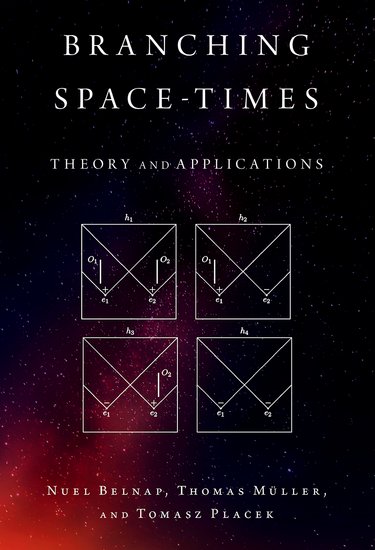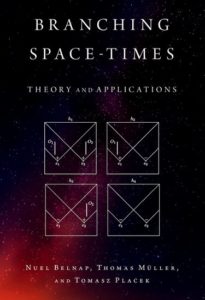 This monograph presents the first detailed exposition of the formal theory of Branching Space-Times. The theory presented here by Nuel Belnap, Thomas Muller, and Tomasz Placek describes how real possibilities can play out in our spatio-temporal world. In our world, some things that are really possible in Cleveland are not really possible in San Francisco; other things were really possible in 1988 but are not really possible in 2021. The authors develop a rigorous, relativity-friendly theory of indeterminism as a local and modal concept, demonstrating that our world contains events with alternative possible outcomes.
This monograph presents the first detailed exposition of the formal theory of Branching Space-Times. The theory presented here by Nuel Belnap, Thomas Muller, and Tomasz Placek describes how real possibilities can play out in our spatio-temporal world. In our world, some things that are really possible in Cleveland are not really possible in San Francisco; other things were really possible in 1988 but are not really possible in 2021. The authors develop a rigorous, relativity-friendly theory of indeterminism as a local and modal concept, demonstrating that our world contains events with alternative possible outcomes.
The book is divided into two parts. The first contains the exposition of the theory, including detailed proofs. The second contains three applications of Branching Space-Times in metaphysics and philosophy of science, focusing on the use of Branching Space-Times to represent pertinent forms of indeterminism in each area. Some specific applications include a formal analysis of modal correlations and of causation and a rigorous theory of objective single-case probabilities, intended to represent degrees of possibility. The authors link their theory to current physics, investigating how local and modal indeterminism relates to issues in the foundations of physics, particularly in quantum non-locality and spatio-temporal relativity. They also relate the theory to philosophy of time, showing how it may be used to explicate the dynamic concept of the past, present, and future based on local indeterminism.
The Branching Space-Times theory has been in development over the past 25 years. This volume provides a much needed first systematic and comprehensive book-length exposition of both the theory and its applications.
This is an open access title available under the terms of a CC BY-NC-ND 4.0 International license. It is free to read at Oxford Scholarship Online and offered as a free PDF download from OUP and selected open access locations.
Branching Space-Times
Theory and Applications
Nuel Belnap, Thomas Müller, and Tomasz Placek
Oxford Studies in Philosophy of Science
Overview
- First book-length presentation of the theory of Branching Space-Times, provided uniformly and with a didactically motivated structure and streamlined notation
- Shows how vexing issues of causation, single case probabilities, the philosophy of time, and indeterministic aspects of the foundations of physics can be addressed within the formal framework of Branching Space-Times theory, leading to rigorously established results
- Includes detailed proofs, motivational stories and diagrams, exercises following each chapter, and advanced work in the appendices, intended to guide readers to grasp the formal concepts and think independently of the issues raised
Table of Contents
Preface
I The Core Theory
- Introduction2. The Foundations of Branching Space-Times
3. Two options for the branching of histories
4. Building upon the foundations of Branching Space-Times
5. Modal funny business
6. Causation in terms of causae causantes
7. Probabilities
II Applications
- Quantum correlations
9. Branching in relativistic space-times
10. A Branching Space-Times perspective on presentism
III Appendix
A. Selected proofs and additional material
B. Answers to selected exercises
Bibliography
Index
Preface
This book concerns indeterminism as a local and modal concept. At its heart lies the notion that our world contains events or processes with alternative, really possible outcomes. We assume that our world is indeterministic in this sense, and we set ourselves the task of clarifying what this assumption involves.We address this task in two ways. First, we provide a mathematically rigorous theory of local and modal indeterminism. Second, we support that theory by spelling out the philosophically relevant consequences of this formulation and by showing its fruitful applications in metaphysics. To this end, we offer a formal analysis of causation, which is applicable in indeterministic and non-local contexts as well. We also propose a rigorous theory of objective single-case probabilities, intended to represent degrees of possibility. Third, we link our theory to current physics, investigating how local and modal indeterminism relates to some aspects of physics, in particular quantum non-locality and spatio-temporal relativity. We also venture into the philosophy of time, showing how our resources can be used to explicate the dynamic concept of the past, present, and future based on local indeterminism.
The theory that we put forward and develop here was launched by Nuel Belnap in 1992, and is called Branching Space-Times (BST). As stated in the founding paper, the aim is to answer the following question: “How can we combine relativity and indeterminism in a rigorous theory?” The combination of non-relativistic time and indeterminism was already wellknown from Arthur Prior’s ideas of so-called Branching Time (BT) and related semantic models; the challenge was to accommodate space-like related events, as known from the special theory of relativity. One aspect of space-like relatedness, the absence of causal connections, was also needed in another research program that Nuel Belnap was involved in with his collaborators in the 1980s. This was the so-called stit program in the theory of agency and action, where “stit” is an acronym for the agentive notion of “seeing to it that” (see, e.g., Belnap et al., 2001). A careful analysis of causal dependencies and independencies is very much needed in the theory of collaborative actions. Some insights from this project then became useful xii preface for the formulation of BST. The central idea of BST, in agreement with BT, is to represent events as being partially ordered. A partial order leaves room for some events to be incomparable. BST shows that certain incomparable events can be understood to be space-like related, and these could, for example, represent the actions of independent agents. Thus, despite the present book’s focus on applications to physics, it is worth keeping in mind that the initial inspiration for BST came from a problem in the theory of agency. Limitations of space means that we do not develop BST as a theory of agency in this work but there are, however, several promising ideas for combining the stit program with BST (see, e.g., Belnap, 2003a, 2005a, 2011).
Many of the formal results presented in this book, as well as the philosophical discussions that surround them, have been published in papers we have written (sometimes with collaborators) over the past twenty-five years. Although this book has been written entirely afresh, we acknowledge the particular papers that provided the basis for the content of several of our chapters.
Chapter 2 presents the results and discussion of the BST founding paper (Belnap, 1992), of which there is also a postprint providing additional information (Belnap, 2003b). A recent alternative formulation of BST is the topic of Chapter 3, which draws on the paper of Belnap et al. (2021). The BST theory of events and propositions was initially presented in Belnap (2002), sets of transitions were investigated in Müller (2010), topological issues in BST were studied in Placek and Belnap (2012), Müller (2013), and Placek et al. (2014)—these five papers are relevant for Chapter 4. Our investigation of non-local modal correlations in Chapter 5 builds on the earlier work reported in Belnap (2002, 2003c) and Müller et al. (2008). Chapter 6 extends Belnap’s (2005b) theory of originating causes (causae causantes), making it applicable in non-local contexts as well. Chapter 7 gives a BST-based theory of objective single-case probabilities; our earlier publications relevant to this topic are Müller (2005), Weiner and Belnap (2006), and Belnap (2007). Chapter 8 then applies our accounts of non-local modal correlations and objective single-case probabilities to analyze nonlocal quantum correlations. Over the years, quite a number of papers have appeared on this topic, starting with Belnap and Szabó (1996) and including Placek (2000), Müller and Placek (2001), and Placek (2010). In Chapter 9, the sections on Minkowskian Branching Structures draw on Müller (2002), Wroński and Placek (2009), and Placek and Belnap (2012). Sections on the Hausdorff property and on bifurcating curves in General Relativity build preface xiii on Luc and Placek (2020), whereas for our discussion of determinism and indeterminism, the relevant papers are Müller and Placek (2018) and Placek (2019). Finally, Chapter 10 integrates material from Müller (2006, 2019) and from Placek (2021).
Open Access
This is an open access title which is free to read and download.

[/tab]
[/tabs]
- Filozofia medycyny – Władysław Szumowski - 5 lipca 2025
- Kosmos i życie - 26 czerwca 2025
- W trzydziestą rocznicę śmierci Józefa M. Bocheńskiego (1902−1995) - 26 czerwca 2025

